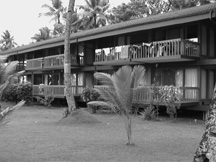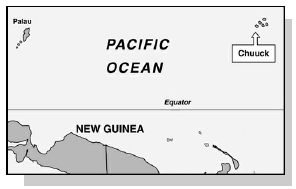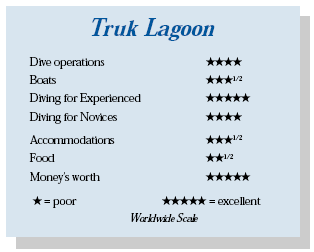Truk Lagoon, MicronesiaContents of this Issue: Travel Insurance in a Time of Terrorism Dive Travel in These Turbulent Times Dacor Recall and Phony Tank Testing The State of the World’s Reefs Editorial Office: Ben Davison Publisher and Editor Undercurrent 3020 Bridgeway, Suite 102 Sausalito, CA 94965 one by land, three by sea from the October, 2001 issue of Undercurrent
Dear Fellow Diver: After a beautiful April sunset behind the island of Tonoas in Truk Lagoon, I backrolled into the water to drop to the Fujikawa Maru resting beneath. Nine backrolls later, our parade of marker lights rained down on the soft corals on this World War II Japanese cargo ship resting upright at 15 to 110 feet. The derricks and king posts had been transformed into figurative McDonald’s arches draped with a rainbow of soft coral, each brilliant bush battling for room to blossom and feed. This was my fourth night in Truk and my first repeat dive. Soon, I was at 95 feet in the No. 2 cargo hold, revisiting several Zero fighter fuselages, propellers, engines and cowlings. A few unexpected bumps into other divers and wreckage reminded me that my purpose was different on this night dive -- it was about corals, creatures, and their transformation from day to night. An undulated moray, attracted to my video light, took me on a guided hunt around the pilot house, waiting impatiently for my light if I paused to film. As I slowly ascended in a spiral around the stack, an octopus came out for a round of peak-a-boo, never fully leaving his rusted home. The Fujikawa was worth its “must dive” rating, both day and night. And just one of many underwater reasons to make the long trek to Micronesia and the islands of Chuuk. You see, Houston to Truk Lagoon covers 8,100 miles, 21 hours and changing planes in Honolulu and Guam. Some airlines allow a layover up to 72 hours at no additional charge in Honolulu; I didn’t take it and my aching coach-class body resents my choice. Chuuk, by the way, is a member of the Federated States of Micronesia, for which America assumes both foreign policy and defense responsibilities. Guam is an American territory. At the Chuuk Airport, the Blue Lagoon Resort (BLR) crew packed our bags into a curious caravan of vehicles for the 15-minute creep to the resort. BLR is built on a WWII Japanese airfield and has most of the sandy, swimmable beach on Weno Island. Before he passed away last year, owner Kimiuo Aisek recruited his nephew Mason, from Hawaii, to manage the BLR. “When a Chief asks,” he said, “you better take that request very seriously.” While Kimiuo’s son Gradvin now owns the hotel and dive shop, Mason’s American-style business savvy and his willingness to do most anything to help guests was shared by most of his staff (despite grocery stores with American prices and staff earning $1.25/hour). BLR has more than 50 rooms, all with balconies facing the lagoon, mini-refrigerators, ceiling fans and TV’s that receive three English-speaking channels programmed by someone playing movies on a VCR. They recommend drinking “purified” water from a 5-gallon jug in a room dispenser, but when I spotted a serious clump of green algae in my dispenser I passed. I had no water pressure for two mornings, so no flushing or showers until the pressure returned after breakfast. But, being on the ground, rather than a live-aboard, has one big advantage -- you can do it for less money. The dive shop dock, lockers and rinse tank are at the hotel (the shop is 300 feet away, but you need to visit it only to check in). Blue Lagoon Dive Shop’s (BLDS) wooden skiffs with sunshades hold six divers comfortably. When more show up between January to March, it would be crammed. The guides and drivers were always helpful setting up equipment and swapping tanks. After the first day, three divers on doubles got their own boat and guide, better for everyone. Rides to the wrecks were sometimes pleasant and other times major butt-busters with mask-on-face to protect me from the spray. During a surface interval on Eten Island, I made a belated safety check of the skiff. I asked our guide Chiney, “What if someone gets a hit? Is there a communication system or O2?” “Yeah,” he said, “I’ll bring it tomorrow.” True to his word, he proudly displayed a DAN O2 kit stowed onboard the next day. I didn’t know what to think about the poor diver on another skiff who may have actually needed the O2 while it was on my skiff. Yelling from boat to boat appeared to be the only communication device. What one might expect, I suppose, at land-based prices . Chiney is the saltiest of the diveguides, based on years of experience, knowledge, and the fade of his wetsuit. While his pleasant face shows signs of the sun’s intensity, he appears ageless, maybe in his 50’s, and is soft-spoken with a contagious smile and laugh. He usually found and hooked the wrecks quickly, then gave a thorough, mostly intelligible briefing. His guiding made great dives even better. The only limits were dirty looks from my fellow divers and me at anyone who decided to grab a few more minutes of bottom time, which added 30 minutes of deco-time.
Those who stayed out of deco, as agreed, rocked and rolled in the skiff. Experiences within the wreck were largely based upon our guides’ skills and their impression of the divers’ skills. I carefully glided through many penetrations and they got progressively more interesting throughout the week. Riding down the anchor line, at 60 feet I reached the massive superstructure of the Kansho Maru, which was dotted with Tridacna clams surrounded by halos of multicolored anthias. Working along the deck at 80 feet, while watching divers silhouetted by corals and seafans, I played with the turning mechanism of the bow gun, while a hawkfish perched on the barrel. The deck was a superhighway for saddled butterflyfish, sailfin tangs, parrotfish, sweetlips and an occasional banded pipefish. The well-preserved pilot house has a readable engine telegraph still capable of smooth operation. Pulling myself through the cabins and living space brought me to the galley, where a departing group had killed the visibility. I felt my way across a beautiful white tile floor with water faucets less than a foot above the tiles. The visibility cleared as I pulled myself out a window and onto a walkway facing the stern. Our guide was already swinging the group over to the engine room, a relatively easy penetration. I didn’t dive the deep “Million Dollar Wreck,” the San Francisco Maru, which apparently beats the shallower wrecks hands down. It reportedly contains mines, munitions, aerial bombs, vehicles, tableware, mess kits, torpedoes, three battle tanks on the main deck, an easily accessible engine room, -- and toilets, a must shot for photographers. The opportunity to dive the San Francisco Maru is motivation enough to go through training for extended-time technical diving to earn some bottom time where few have traveled (and, therefore, few have stolen artifacts). But, don’t reject Truk because you think it’s only for advanced and technical divers. I saw plenty of amazing sights above 100 feet, as did the rookies in our group. While I made three deco-dives during the week, the others were within sport diver limits. Halfway through a 19-dive package, my whole boat seemed ready for a shallow diversion for our third dive of the day: We wanted reef. Weather and distance seemed to forbid a trip to Jeep Island (on the fringe of the lagoon) with its ripping tidal currents, creatures and sharks. So we settled for what became a mediocre dive near the Fujikawa Maru. Other than a passing glance at a black-tipped reef shark, the reef offered little more than mountainous hard corals rising from the 20-40 foot sand bottom. Here, however, was the nursery for Truk Lagoon. Being into fish spotting, I made the most by trying to identify the juveniles. Last year, my dive buddy made reef dives at Shark Island and Northeast Pass, a sloping reef beginning at 25 feet and dropping to sand at 110 feet with dense, healthy antler and plate corals. She found plenty of tropicals, including anemonefish, regal angelfish, foxface rabbitfish, black tip and whitetip sharks, an occasional crown-of-thorns, and Tridacna clams. The shallowest battle tanks in Truk Lagoon are on the Nippo Maru, famous for
pilot house shots of divers and artifacts next to the brightly colored engine
telegraph. With the Truk Aggressor solidly moored to its lines, Chiney saw the Aggressor ’ s divers all at a safety stop on
the line. The mooring line on the Nipo Maru is potentially more dangerous to divers than hooking the wreck. Like most Aggressor-placed moorings, it’s about 20 feet off the bow. These lines are often difficult to spot and challenging to reach from the superstructure while battling current. If the moored Aggressor happens to swing over the wreck, they drop ascent lines to help divers finish exploring the wreck at its shallowest point, often the superstructure and rarely the bow. Rebar hooks, once in place, improve diver safety. That should at least balance if not trump the seemingly negligible wear and tear to the wrecks from thirty years of being hooked. Better, tighter placement of more mooring lines (a cost BLDS couldn’t begin to pay) would negate the advantages of hooks while still allowing multiple boats per wreck in their busy season. So, while the Aggressor Captain offered third world people just another reason
to resent American big-buck arrogance, we Michigan divers were not happy either,
having been delayed 30 minutes, enough for some divers to get seasick. Finally, I
found myself at the bow gun where a red-lipped blenny, having made a home of the
barrel, invited me to stay awhile. Swinging down toward the tank, a graceful eagle
ray whose spots appeared to be baby blue distracted me. One advantage of diving with a landbased operation is the opportunity to stretch your legs, try a few bars and restaurants and see the sights, if there are some. BLR’s Island View Restaurant was decent, but painfully slow. I went for the banana pancakes for a consistent, and inexpensive breakfast, and stuck with the Asian foods, especially soups and noodles. I quickly learned that what I had yesterday may be unavailable today, particularly fresh fruit. I ordered a box lunch the night before to eat between dives. The Truk Stop Hotel and Restaurant had good pizza, steak and lobster, priced $15-$30 with a drink. Alas, the plate for eating pizza wasn’t appetizing as it was covered in ants and I crunched a rodeo-sized cockroach under my foot on each of my two visits. The Truk Stop is the only other hotel that might be suitable for divers, but it is a quarter mile downwind from an active landfill and adds ten minutes to each leg of your boat ride to most sites. The island of Moen has almost nothing to see. I visited the Civil Action Team (CAT) House, a U.S. Air Force station that provides medical services and helps the Chuukese improve their infrastructure. Everyone from the commanding officer to the lowest ranking sergeant welcomed me. I drove a BLR rental car to explore the Japanese Lighthouse, which requires a moderate hike on basic trails, led by at least a dozen locals, many of whom gladly accept tips. Halfway up the trail, I paid $5 and was led on “the path less traveled” to avoid being spotted by other families who might want to charge me, as well. The Lighthouse looked more impressive from a distance, without seeing all the graffiti. Some kids made me feel comfortable; others made me feel like an intruder. Ultimately, the spectacular panoramic views made it a worthwhile journey. Most divers opt for one of the three live-aboards, the Thorfinn, Aggressor, or the Odyssey. Mason told me that more live-aboards have applied but the Chuukese government has said no. The Thorfinn was in sight all week, moving only the last day to drop off passengers to go to the airport. A 146-foot converted whaler powered by an enormous steam engine, it’s rough around the edges, with winding passageways from one part of the ship to another. However, the stability and size make it well-suited for exploring outside the lagoon. It schedules annual cruises to Yap, and diving islands along the way that rarely see visitors. It has E-6 processing, video camera rentals, two camera tables on the main deck with 110/220V charging points, light tables, projector, TV/VCRs in the staterooms and the lounge, and e-mail/Internet access for passengers. The Thorfinn shuttles divers to wrecks on its four steelhulled six-passenger chase boats (which don’t have sun protection). With five dives scheduled daily, there’s plenty of bottom time. Though no depth limits are imposed, divers are encouraged to stay out of decompression and to make extended safety stops starting at 60 feet. Hang tanks with regulators are available at the shallower stops. Nitrox up to 40 percent is available for shallower dives, or in ponies for off-gassing. Unlike other Truk live-aboards, one can book any number of days on the Thorfinn. One of my buddies aboard the Thorfinn last year said the dive operations had difficulty finding some wrecks, and dropped the group in the sand at 120 feet on one dive. The weekly rates on the Thorfinn are less than the Odyssey or Aggressor. Touring the Odyssey, I found a top-notch operation led by husband-wife team Kara and Lenny (who formerly captained the Truk Aggressor). In Truk for two years, the Odyssey is a refitted 126-foot compact cruise ship with a luxury feel. Nine cabins with ensuite facilities are well laid out, and a spacious lounge, saloon, and part-shaded sun deck leave space to spread out. Video/photo facilities include daily E-6 processing, camera table, rinse tanks, slide table, charging station, and instruction. They usually move from wreck to wreck twice a day, with all divers on the same wreck at the same time, making two dives before moving on. Dives on the outer reefs are an option, with a shark-feeding dive available on group request. A single tender shuttles divers to and from shore, and makes occasional runs to other wrecks. A hang bar with tanks is used for safety stops. For an extra $250/week, double 80’s with isolation manifolds and ponies are available, as are Nitrox mixes of up to 80 percent for deco-stops (100 percent at extra charge). Contact them ahead of time to be certain you meet their equipment and certification requirements. A membrane system provides Nitrox at no charge for recreational divers, as well. The Odyssey is the only operation capable of supporting such depths with the benefit of multiple mixes for staged decompression and the benefit of higher O2 mixes to reduce hang time. The major reason to choose land over live-aboard in Chuuk is that land is less expensive. Based on prices published before September 11 and comparing apples to apples, the Thorfinn will be the least expensive live-aboard at $2,195 for a week. The Odyssey is $2,295 (add $250 for technical diving upgrade) and Truk Aggressor II $2,495 ($200 less for a quad). These prices include Nitrox. A seven-night package at BLR with 12 dives is $1,077, and for three tanks per day and two night dives it’s $1,457, then add another $300 for meals. (Nitrox is not available.) While liveaboard phobic divers may prefer land, keep in mind that the live-aboards here don’t face weathering storms that interrupt sleep and diving. Serious wreck divers will find the Odyssey the best choice ... and hope for an attitude adjustment aboard the Aggressor, now with a new Captain, Niall Lawlor. -- D.H. |

I want to get all the stories! Tell me how I can become an Undercurrent Online Member and get online access to all the articles of Undercurrent as well as thousands of first hand reports on dive operations world-wide
| Home | Online Members Area | My Account |
Login
|
Join
|
| Travel Index |
Dive Resort & Liveaboard Reviews
|
Featured Reports
|
Recent
Issues
|
Back Issues
|
|
Dive Gear
Index
|
Health/Safety Index
|
Environment & Misc.
Index
|
Seasonal Planner
|
Blogs
|
Free Articles
|
Book Picks
|
News
|
|
Special Offers
|
RSS
|
FAQ
|
About Us
|
Contact Us
|
Links
|
3020 Bridgeway, Ste 102, Sausalito, Ca 94965
All rights reserved.


 So he hooked the wreck (BLDS’s
usual practice) by swinging his rebar hook
onto the rail. Chiney soon felt like a
fisherman who just lost a lure. Stew
Esposito, the Aggressor Captain, had swum
out and cut Chiney’s line, which he proudly
announced upon surfacing. Dripping with
arrogance, Stew yelled that he “had been
telling you guys not to hook the wrecks!”
This time he decided to be judge and jury
of his own law. An embarrassing case of a
guy like Stew telling the locals who had
been guiding dives here decades longer than the Aggressor, how they must preserve
their local dive environment. Sixty years in salt water -- not BLDS’s hook -- is
slowly eating these steel wrecks and their cargo. I could see the spots where the
wrecks had been hooked (three pieces of rebar about 2.5 feet long, curled out 180
degrees and clamped together, weighing less than 5 pounds). Nothing appeared broken,
ripped or ruined, besides discrete patches of coral, sponge or algae. The argument
for mooring lines plays better in reef environment then it does where huge steel
ships are the attraction.
So he hooked the wreck (BLDS’s
usual practice) by swinging his rebar hook
onto the rail. Chiney soon felt like a
fisherman who just lost a lure. Stew
Esposito, the Aggressor Captain, had swum
out and cut Chiney’s line, which he proudly
announced upon surfacing. Dripping with
arrogance, Stew yelled that he “had been
telling you guys not to hook the wrecks!”
This time he decided to be judge and jury
of his own law. An embarrassing case of a
guy like Stew telling the locals who had
been guiding dives here decades longer than the Aggressor, how they must preserve
their local dive environment. Sixty years in salt water -- not BLDS’s hook -- is
slowly eating these steel wrecks and their cargo. I could see the spots where the
wrecks had been hooked (three pieces of rebar about 2.5 feet long, curled out 180
degrees and clamped together, weighing less than 5 pounds). Nothing appeared broken,
ripped or ruined, besides discrete patches of coral, sponge or algae. The argument
for mooring lines plays better in reef environment then it does where huge steel
ships are the attraction. The ray swam 10 feet away
doubling back and passing in front of me
whenever I was falling behind. A quick
inspection of the well-preserved vehicles
and tank at 125 feet, then off to the
brilliant red encrusting sponges adorning
the helm and engine telegraph. A gas mask
had been draped over the helm for good
measure. This was one experience worth a
little hang time.
The ray swam 10 feet away
doubling back and passing in front of me
whenever I was falling behind. A quick
inspection of the well-preserved vehicles
and tank at 125 feet, then off to the
brilliant red encrusting sponges adorning
the helm and engine telegraph. A gas mask
had been draped over the helm for good
measure. This was one experience worth a
little hang time. Diver’s Compass: Peak time is January through March (the dry months),
with April being the best diving month. August is the wettest month;
November is typhoon season ... $30 dive permit required; no waivers
signed at BLD; some showed c-cards, others didn’t ... Rental gear is
fair, about ten sets of mostly Scubapro and Seaquest BCD’S and regulators
(Mk-10/G-250s), but watch out if you’re “Big.” Same problem in
sizing for limited wetsuits ... No on-land film developing. Come
self-sufficient, because there is little in the way of useful parts and products for
divers ... Frisbee golf course at BLR; kayaks available. Water 82-84; air mid 70’s
to low 90’s; sun hot and shaded portions of skiff were welcome ... No amenities for
video or photography ... $10 extra for additional tanks used by doubles divers ...
Air fills in the 2600-3000 range, with an occasional near-empty cylinder; got better potenafter
divers complained ... Gray reef and blacktips on every other dive; lionfish on
Kansho Maru always in the same spot. BLDS hung three weighted deco-lines, one with a
cylinder and three regulators; visibility 30-80 feet, much less if you were in
the rear of a procession ... Truk Stop Hotel, 691-330.4232/3, fax: 691-330-2286,
Diver’s Compass: Peak time is January through March (the dry months),
with April being the best diving month. August is the wettest month;
November is typhoon season ... $30 dive permit required; no waivers
signed at BLD; some showed c-cards, others didn’t ... Rental gear is
fair, about ten sets of mostly Scubapro and Seaquest BCD’S and regulators
(Mk-10/G-250s), but watch out if you’re “Big.” Same problem in
sizing for limited wetsuits ... No on-land film developing. Come
self-sufficient, because there is little in the way of useful parts and products for
divers ... Frisbee golf course at BLR; kayaks available. Water 82-84; air mid 70’s
to low 90’s; sun hot and shaded portions of skiff were welcome ... No amenities for
video or photography ... $10 extra for additional tanks used by doubles divers ...
Air fills in the 2600-3000 range, with an occasional near-empty cylinder; got better potenafter
divers complained ... Gray reef and blacktips on every other dive; lionfish on
Kansho Maru always in the same spot. BLDS hung three weighted deco-lines, one with a
cylinder and three regulators; visibility 30-80 feet, much less if you were in
the rear of a procession ... Truk Stop Hotel, 691-330.4232/3, fax: 691-330-2286,
